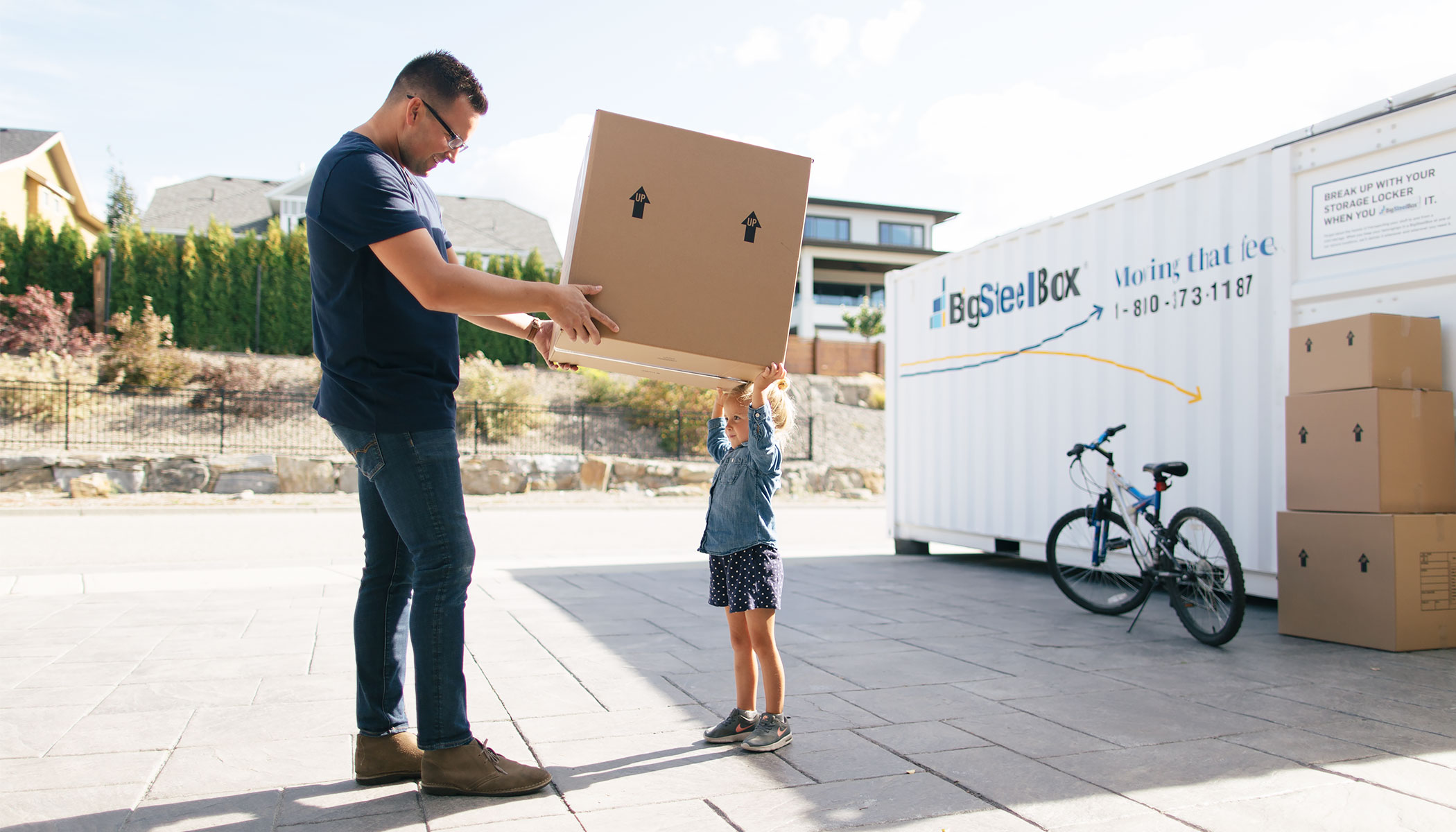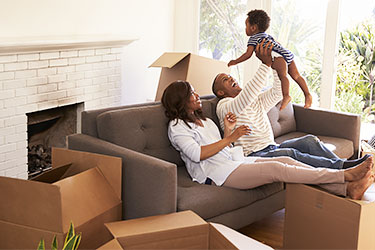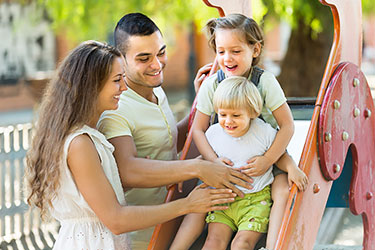
9 Tips to Make Moving Easier for Kids - BigSteelBox
How to Move With a Toddler Easily
Post updated on September 5, 2023
Moving can be a challenge at any age, but it can be even more stressful for kids who aren’t part of the decision-making process. Whether your children are toddlers or teenagers, there are always additional challenges to moving when kids are involved.
 And, while uprooting a teenager or switching your child’s school is often difficult, moving a toddler has its own set of challenges. It’s important to let your child know that they’re not leaving their bed and toys behind, and that you will all be there together as a family when you move into your new home. The more they understand this, the easier it will be for them to accept this change in their life.
And, while uprooting a teenager or switching your child’s school is often difficult, moving a toddler has its own set of challenges. It’s important to let your child know that they’re not leaving their bed and toys behind, and that you will all be there together as a family when you move into your new home. The more they understand this, the easier it will be for them to accept this change in their life.
Helping a younger child deal with change is all about validating their fears and feelings, listening to them, and laying out expectations for them in ways that they can understand. Make your message about this change positive and clear, and reinforce it many times as you lead up to the move.
Read on for some ways you can ease this big transition and make moving with kids a little easier.
Tips to Make Moving Easier for Kids – Table of Contents
- See the move from your child’s perspective.
- Talk to your kids about moving.
- Take your child to your new community before the move.
- Stick to your routine.
- Be patient with your child.
- Be strategic about packing your kids’ things.
- Have a plan for moving day.
- Keep safety top of mind when moving.
- Allow time to unpack and get settled.
1) See the move from your child’s perspective.
Adjust your point-of-view to understand how your child sees the move. Will they be leaving the place they’ve called home their entire life? Are they having to leave family and friends they’re used to seeing regularly? If so, that can be a scary thing.
Toddlers prosper with structure and routine, so not only will they be feeling the loss of their home, but they may also be disoriented due to the many changes happening around them. It will be normal for them to exhibit uncharacteristic or frustrated behaviour at this time.
Once a child knows there’s nothing they can do or say to change the fact that they’re moving, they may feel helpless. Many toddlers act out physically when dealing with a big change and it’s crucial they feel heard and accepted even during an outburst. Only by seeing the reason behind bad behaviour will you be able to address it and help them, so be patient with your child as they deal with their emotions. They may need a little extra attention and understanding, which will put even more demands on your time, so be ready for this.
2) Talk to your kids about moving.
Processing a move can be hard for toddlers, so start talking to them about the move as far in advance as you can to help prepare them.
Your toddler may not be able to fully grasp the concept of moving into a new home, but it’s important to let them know it is happening ahead of time. Preparing your child before the move will have a big impact on how easily they will adapt once they’re in the new home.
Here are ways to make the conversation with your little one go smoothly:
- Let them know that everything will stay the same in the new home. If their routine and family structure will not change, tell them that.
- Emphasize that you will be taking all of their stuff with you. Their toys, blankets, and furniture won’t be left behind.
- Try using a story to convey the situation to them in terms they can understand.
- Get down to their level. Pick up your child or sit with them so that you can make eye contact.
- Let them know what to expect on the day of the move without overwhelming them with too much detail.
- Slow down and watch for your child’s nonverbal cues so that they know you’re really listening to them.
- Talk normally and in full sentences without using baby talk. Slow your speech down and give them time to fully comprehend what you’re telling them.
- Offer your toddler real choices to make them feel like they’re not helpless. Do they want to carry a special toy with them? Do they want to pick out their own outfit for moving day?
3) Take your child to your new community before the move.
Once your toddler understands that nothing bad is going to happen, you can start getting them excited about the move. If possible, take them to your new neighbourhood and show them around. Is there a park close by? Take them there! Start making positive associations with moving to the new area and your toddler will see it as an adventure, not a loss.
 If possible, organize a playdate in the new area or visit the local playground to get to know the kids there. Get them excited about the relationships they’re going to make and foster in the future. Relate your move to the fun people in the new neighbourhood to make it appealing.
If possible, organize a playdate in the new area or visit the local playground to get to know the kids there. Get them excited about the relationships they’re going to make and foster in the future. Relate your move to the fun people in the new neighbourhood to make it appealing.
Have you chosen a new daycare or play school in your new neighbourhood? If so, take your child there for a visit to meet the caregivers and teachers so they know what to expect on their first day.
If you’re moving long distance and can’t bring your child to the area before you move, try teaching them about your new town, city, or province. Show them pictures and tell them about all of the fun things that will be waiting for them once they move. Make the story about the new place, not the one you’re leaving. Compile a list of the parks, ice cream shops, libraries, schools, and friends’ houses that will be waiting for them once you move.
4) Stick to your routine.
If you have a bedtime routine in place or a napping schedule, try to keep that as consistent as possible before, during, and after your move. Children fear the unknown, and this move is a big unknown for them. Maintaining their basic day-to-day activities at regular intervals can help calm those fears and anxieties.
Routines help children learn to make decisions for themselves and take charge of their day. When they consistently have a nap on schedule then they naturally get tired at that time. That sense of control is crucial with such a big change coming in the near future.
Establish that same routine in your new home as quickly as possible. Even though the walls around them have changed your child will feel that their world is still the same. This routine will also help your child go to bed on time, and a well-rested toddler is a happier toddler. This may mean that you unpack a little slower than you’d like, but the payoff is worth it.
5) Be patient with your child.
For all your upbeat conversations and well-intentioned neighbourhood playdates, your child might still be anxious about the move. That is perfectly normal, so allow them to express their anxiety. Answer any questions they have about the move and be prepared to give them the space they need. Keep your answers clear and simple. They will adjust to your new home eventually, but it may just take some time to process.
Here are some tips for being patient with your toddler:
- Pick your battles. This is a hectic time already, so your child’s behaviour is not going to be perfect. Accept that some rules will not be followed.
- Give yourself a timeout to unwind. Have a cup of tea or go for a short walk when things get to be a little too much.
- Ask for help when you need it. You may need a babysitter or an extra set of hands while you pack your things in order to keep your child’s routine consistent. That’s ok!
- Count to ten. When you’re feeling frustrated, take 10 seconds to calm down before you act on that frustration and it will do wonders for your patience.
- Enjoy some time with your child in your home before you leave it. Make some memories in this home and really soak in these moments.
6) Be strategic about packing your kids’ things.
 Leave your child’s things to the end of your packing. Avoid packing up their bedroom until you absolutely have to so that they have a familiar place to retreat to as the house around them changes.
Leave your child’s things to the end of your packing. Avoid packing up their bedroom until you absolutely have to so that they have a familiar place to retreat to as the house around them changes.
When you do pack up your child’s things, involve them in the process. Help them fill a box with their toys so they feel included. Take special care of that box and label it in a way that your child can understand.
If you’re moving with a BigSteelBox, pack the boxes with your child’s things into the moving container last, so they will be the first things that you unpack and open in your new home. Make a big deal about unpacking it and emphasize that the rest of their things will be unpacked shortly too.
7) Have a plan for moving day.
Arrange for your toddler to have a babysitter for moving day if you’re moving locally. With boxes and furniture being moved, the noise and chaos of the day is no place for small children. There are too many distractions for you to give your toddler your full attention, so it’s best to leave them out of it. Just make sure that they arrive in your new home with enough time before bedtime to explore the house or they may not be able to get to sleep!
If a babysitter is not an option for you, take the time to explain what is happening step-by-step to your child. Those boxes will be transported to your new home, they’re not going to disappear. Give them extra attention and include them in the process by asking them to watch over a very special stuffed animal or to take care of that bright blue sippy cup.
When everything is packed and out of the old house, walk your toddler from room to room to say goodbye. Let them take their time and answer any questions they may have on your tour. This closure can be good for both you and your child.
8) Keep safety top of mind when moving.
Keeping your child safe during and after a move is important. If possible, try to “baby-proof” your house before your child arrives. Your child will want to explore their new surroundings so there’s a higher chance of them getting into things they shouldn’t.
Here are some precautions you can take to ensure your child’s safety:
- Put away cleaning supplies and anything else your child could ingest.
- Don’t stack your boxes too high or leave piles of things laying around.
- Bring your first-aid kit with you when you move, don’t pack it away in a box.
- Have your emergency numbers programmed into your phone or write them down and stick them on the fridge.
- Make a safe space right away where your child can roam free.
- Let your child explore each room as they are set up. Make each room a surprise to keep them out of unwanted areas.
- Get your child out of the house while furniture is being set up. This is a great time to visit that local park you’ve been raving about for the past month.
- Don’t leave cords or scissors within reach of your toddler.
9) Allow time to unpack and get settled.
It’s important to build a sense of familiarity for your toddler shortly after your belongings are delivered to your new home. If possible, don’t throw out any of your child’s old furniture or make any upgrades right away.
Unpack their things first and bring out their favourite book or toy right away to give them a sense of security. It may be tempting to bring out your dishes or clothing right off the bat, but this small act of kindness sets the tone for the first few days in your new home.
Try to keep your child’s schedule the same for these days. It’s a big chore to set up a new home and you may be feeling overwhelmed, so this consistency can be good for you too. Feed and bathe your child at the same time as always and take some time out of your day to play with them.
In the first few weeks of your new living situation your child is going to need more assurance and soothing from you than they usually do. Make sure you are available to them every day. Take reduced hours at work or hold off on dinner plans until your new house feels like home to your child. Read them a few extra bedtime stories; the unpacking can wait.
Now that we’ve passed along our top tips to make moving easier for kids, you parents might have some questions or need some extra tools. Here are a some things that might help:
You might be wondering, is moving good for kids?
We know that moving is tough for children, but can it have a positive effect on them too? Of course it can!
Staying in one house for your whole childhood is not the only way to create stability. Empowering your toddler by offering simple choices and talking to them about the moving process allows you to lessen their anxiety and remind them that you are a constant in their life.
Moving teaches your child important lessons, especially about how to deal with change. How well they learn that lesson is partly determined by your child’s personality and partly by how you handle the situation. It’s up to you to create calm in the middle of a storm, and to showcase the attitude you want your child to adopt. You can lead by example.
Your toddler will experience big emotions with a move: excitement, anxiety, fear. This is an opportunity for you to validate those emotions and teach them how to handle them. Accept their emotions without judgement, listen to them, and watch for ways they are communicating physically. By normalizing these big emotions, you are helping your child build self-esteem and hearty emotional health.
Moving with a toddler checklist:
Moving is exciting and exhausting, but also manageable with the right plan. Here’s an easy-to-reference checklist to keep you on track:
- Talk to your child about the move ahead of time.
- Make the move a family experience.
- Allow your toddler to express angst about the move.
- Take a tour of your new community to build positive feelings.
- Maintain a schedule for your child.
- Surround your child with their favourite things before, during, and after the move.
- Pack your child’s things last and unpack them first.
- Create a safe space in your new home and put away anything that can be dangerous.
- Remember that moving can be tough and everyone deals with it differently, but it also can be a rewarding experience.
Moving can bring a family closer and it will show you how your toddler deals with stress. Your child will learn that no matter what changes around them you are still a constant in their life. By being patient and really paying attention to your child’s needs you can set them up for success in your new home and in their future.
Pack and move at your pace with BigSteelBox
Everything takes a little longer when toddlers are involved, so moving with a BigSteelBox is a great option for families with young children because our service allows you more time to pack and unpack.
There’s no need to cram all the stress of packing and moving into one day! BigSteelBox will drop off a moving container at your home as far in advance as you need it. Take your time packing your BigSteelBox – keep it for a week or a month, (or longer!) it’s entirely up to you. When you’re ready, we’ll pick up your BigSteelBox and deliver it to your new home, or store it at one of our secure locations until your new home is ready.
Looking for an affordable way to move long distance? Check out this post: What’s the cheapest way to move across Canada?
Contact us at 1-800-373-1187 to see how we can make your family’s move feel better or request your free quote online now.



